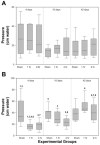Increased duration of simulated childbirth injuries results in increased time to recovery
- PMID: 17204590
- PMCID: PMC2536599
- DOI: 10.1152/ajpregu.00784.2006
Increased duration of simulated childbirth injuries results in increased time to recovery
Abstract
Stress urinary incontinence (SUI) development is strongly correlated with vaginal childbirth, particularly increased duration of the second stage of labor. However, the mechanisms of pelvic floor injury leading to SUI are largely unknown. The aim of this study was to determine the effects of increased duration of vaginal distension (VD) on voiding cystometry, leak point pressure testing, and histology. Sixty-nine virgin female rats underwent VD with an inflated balloon for either 1 or 4 h, while 33 age-matched rats were sham-VD controls. Conscious cystometry, leak point pressure testing, and histopathology were determined 4 days, 10 days, and 6 wk after VD. The increase in abdominal pressure to leakage (LPP) during leak point pressure testing was significantly decreased in both distension groups 4 days after distension, indicative of short-term decreased urethral resistance. Ten days after VD, LPP was significantly decreased in the 4-h but not the 1-h distension group, indicating that a longer recovery time is needed after longer distension duration. Six weeks after VD, LPP was not significantly different from sham-VD values, indicating a return toward normal urethral resistance. In contrast, 6 wk after VD of either duration, the distended rats had not undergone the same increase in voided volume as the sham-VD group, suggesting that some effects of VD do not resolve within 6 wk. Both VD groups demonstrated histopathological evidence of acute injuries and tissue remodeling. In conclusion, this experiment suggests pressure-induced hypoxia as a possible mechanism of injury in vaginal delivery.
Figures





References
-
- Allen RE, Hosker GL, Smith ARB, Warrell DW. Pelvic floor damage and childbirth: a neurophysiological study. Br J Obstet Gynaecol. 1990;97:770–779. - PubMed
-
- Arya LA, Jackson ND, Myers DL, Verma A. Risk of new onset urinary incontinence after forceps and vacuum delivery in primiparous women. Am J Obstet Gynecol. 2001;185:1318–1323. - PubMed
-
- Bakircioglu ME, Sievert KD, Lau A, Lin CS, Lue TF. The effect of pregnancy and delivery on the function and ultrastructure of the rat bladder and urethra. BJU Int. 2000;85:350–361. - PubMed
-
- Bump RC, Elser DM, Theofrastous JP, McClish DK. Valsalva leak point pressures in women with genuine stress incontinence: reproducibility, effect of catheter caliber, and correlations with other measures of urethral resistance. Am J Obstet Gynecol. 1995;173:551–557. - PubMed
-
- Cannon TW, Damaser MS. Effects of anesthesia on cystometry and leak point pressure of the female rat. Life Sci. 2001;69:1193–1202. - PubMed
Publication types
MeSH terms
Grants and funding
LinkOut - more resources
Full Text Sources

